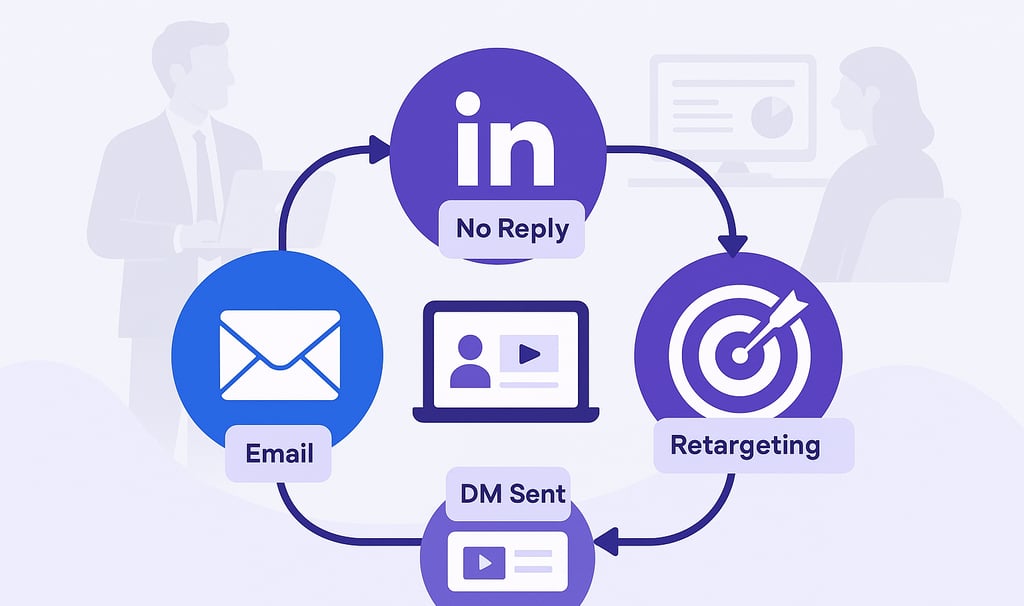The Ultimate Guide to Multichannel Outbound Sequences (Email + LinkedIn + Retargeting)
AUTOMATIONGROWTH
7/15/20253 min read


Your buyer didn’t ignore your email because your subject line was weak.
They ignored it because they didn’t remember you.
And why would they?
One cold email
A couple of uninspired follow-ups
A random LinkedIn connect
Generic ads, if any
None of it sticks if it isn’t sequenced around a single, memorable idea.
In 2025, outbound isn’t about “touchpoints.” It’s about trust points.
Your job isn’t just to reach people. Your job is to create recognition through repetition, without annoying them.
That’s where most outbound teams fail.
They’re not wrong. They’re forgettable.
Where Most Sequences Break
Auditing 50+ outbound systems this year revealed a few common breakdowns:
Emails lack structure. Domains are warmed, but narratives aren’t.
LinkedIn touches are generic or disconnected from email threads.
Retargeting isn’t synced with outbound messaging.
Video is missing entirely, even though buyers consume visually.
In short, the message is there.
The sequence isn’t.
Outbound fails when it operates in silos. It wins when it delivers coordinated touches that build recognition, relevance, and readiness to talk.
From Outreach to Outbound Orchestration
The shift is clear:
Great outbound today isn’t about outreach. It’s about orchestration.
The most effective teams operate like distribution systems:
Email starts the thread
LinkedIn builds trust
Video delivers clarity
Retargeting reinforces the story
Automation tools like Clay, Instantly, and Zapier connect the dots
It’s not about flooding inboxes. It’s about building recall.
Familiarity → Frequency → Follow-up
That’s the loop that turns strangers into conversations.
What Multichannel Outbound Looks Like:
In building GTM programs across SaaS, Fintech, and EdTech, a pattern emerged:
Teams nailed their offer. Had strong ICPs. Even got solid copy.
But the system lacked punch — no visual hooks, no automated logic, and no channel consistency.
So BriskFab added a simple, fast AI-powered video layer to outbound:
30-second product explainers
Social-proof snippets for LinkedIn DMs
Retargeting-ready clips for ICPs
Delivered fast enough to match outbound velocity
Combined with data enrichment (Clay), sequencing (Instantly) or Apollo, and logic-based triggers, this formed a cohesive outbound system.
The result?
Outbound started to feel familiar. Not forced.
Real Use Case: 3X Replies with Sequenced Video + Retargeting
A SaaS team was stuck:
Strong ICP
Sharp offer
Reply rates under 2%
A new multichannel sequence was deployed:
Sequence Breakdown:
Day 1: Email #1 with personalized intro + clear POV
Day 2: LinkedIn profile view + connection
Day 3: Email #2 with explainer video (40s “Why Now”)
Day 4: Retargeting ad with testimonial + quick video case
Day 5: LinkedIn DM with reference to the video
Day 7: Final email with teaser video of “What We’d Build for You”
Results:
Replies: 1.8% → 6.4%
Meetings: 2.3x increase in 10 days
Prospect sentiment: I came across your post first, then saw the email, and later the retargeted video; it all felt natural, so I replied.
Outbound stopped feeling cold.
Because every step warmed the next.
BriskFab’s 5-Step Multichannel Outbound OS
1. Anchor the Narrative
Start with the core GTM story:
What problem does this solve?
Why now?
What’s different?
Turn this into a short video.
Because skimming happens. But video gets watched.
2. Sequence the Journey, Not Just the Messages
Buyers don’t think in steps.
They remember impressions.
Instead of linear cadences, build:
Email → LinkedIn → Retargeting
Or reverse: Ad → LinkedIn comment → Email follow-up
Each touch should compound awareness.
3. Build Native Assets for Each Channel
Email: Thumbnail that previews as explainer video
Retargeting: Punchy 15s hooks customized by segment
4. Trigger Behavior-Based Sequences
Replace static waits with dynamic triggers:
If no email reply → Show video ad
If 50%+ video watched → Drop soft CTA
If LinkedIn connected → Send DM with relevant story
Outbound should adapt to how buyers engage.
5. Measure Real Signals
Look beyond opens and clicks.
Track:
Email replies with curiosity
Video engagement (watch time)
LinkedIn DM response rates
Retargeting-assisted conversions
Content Isn’t a Campaign. It’s a Conversion System.
Outbound doesn’t need more tools.
It needs better coordination.
AI-powered videos. Trigger-based flows. Channel-native content.
All wired to support a clear GTM motion.
That’s the model modern teams are using to drive real pipeline faster.
Want to See It In Action?
Explore how BriskFab helps B2B teams:
Add smart automation and video without extra ops
Turn GTM ideas into sequenced content that sticks
👉 See how BriskFab helps modern GTM teams scale conversations — or share this with the outbound team and say:
“Let’s fix our outbound before Q4.”
FAQs on Multichannel Outbound Sequences
1. What's the biggest difference between traditional and multichannel outbound?
Traditional outbound focuses on cold emails or calls alone. Multichannel outbound builds familiarity and trust across email, LinkedIn, and retargeting to increase conversion likelihood.
2. Do I need a huge tech stack to implement this?
Not at all. Tools like Clay, Instantly, and Zapier can get you started with sequencing, automation, and content.
3. How long should a typical sequence run?
Most successful multichannel sequences run between 7–14 days, with strategic touchpoints every 1–3 days depending on engagement triggers.
4. Can AI video work even in early-stage GTM?
Absolutely. Short-form explainers and social-proof clips help early-stage teams communicate value clearly, without needing large marketing budgets or internal creative teams.
5. What’s the best way to measure if my sequence is working?
Track conversation quality, not just volume. Look at reply depth, meeting show rates, and how often prospects reference your video content or ads during calls.
